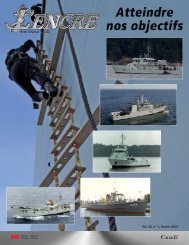You also want an ePaper? Increase the reach of your titles
YUMPU automatically turns print PDFs into web optimized ePapers that Google loves.
on page 6.)<br />
Other naval highlights included Ottawa and Algonquin<br />
training as part of the multinational task group attached<br />
to defend USS Nimitz for the exercise. For them,<br />
RIMPAC 2012 provided an opportunity to train the<br />
sailors of tomorrow. The experience gained and lessons<br />
learned will serve to better prepare the RCN for future<br />
exercises and operations.<br />
Off the coast of San Diego, HMC Ships Brandon,<br />
Saskatoon and Yellowknife, as well as a team from the<br />
Fleet Diving Unit Pacific, conducted more than three<br />
weeks of mine warfare training with U.S. and Australian<br />
counterparts, achieving a high level of proficiency and<br />
individual training.<br />
For the first time in RIMPAC history, component<br />
commander positions were held by non-U.S.<br />
participants. Canada filled the position of Combined<br />
Forces Air Component Commander with Brigadier-<br />
General Michael Hood, a Royal Canadian Air Force<br />
(RCAF) officer currently employed as the Deputy<br />
Director General of International Security Policy at<br />
National Defence Headquarters in Ottawa.<br />
“Working in a coalition setting has its challenges,”<br />
BGen Hood said. “Even native English speakers can<br />
sometimes interpret the same word differently. The fact<br />
that more than 200 aircraft were able to operate safely<br />
throughout the exercise is a testament to the 18 months<br />
of planning and the professionalism of air personnel<br />
from every country who participated in the exercise.”<br />
From the RCAF’s perspective, the exercise provided<br />
many opportunities to meet national requirements. The<br />
maritime patrol and reconnaissance aircraft community<br />
had the opportunity to test the Block III variant of the<br />
aircraft while working closely alongside their Australian,<br />
Japanese, New Zealand, Korean, and U.S.<br />
counterparts. Algonquin’s air detachment had a<br />
landmark day when its Sea King helicopter dropped five<br />
exercise torpedoes in one morning during an antisubmarine<br />
warfare training and research event.<br />
Soldiers from Australia, Canada, Indonesia, Korea, Malaysia, New<br />
Zealand, Tonga and the U.S. march on the flight deck of USS Essex.<br />
Commodore Peter Ellis, right, Commander of Canadian Fleet Pacific<br />
during the exercise, and Lieutenant-General Stuart Beare,<br />
Commander of the Canadian Expeditionary Force Command,<br />
observe exercises during RIMPAC.<br />
For the Canadian Army, the exercise provided<br />
opportunities to conduct interoperability training with<br />
coalition partners, hone their war fighting skills at the<br />
section, platoon and company level, and conduct<br />
validation and continuation training in non-combatant<br />
evacuation, assisting Canadian civilians who need to be<br />
evacuated from areas of conflict.<br />
The exercise followed a tiered training schedule that<br />
allowed participants to follow a crawl, walk and run<br />
pace. The first three weeks were dedicated to honing<br />
individual and unit level skills, followed by a week of<br />
force integration training. This phase, which brought<br />
together more than 25,000 personnel into one combined<br />
force, focused on command and control procedures,<br />
allowing the various units to adjust to the new construct.<br />
The final phase pitted the newly trained combined force<br />
against a fictitious foe in an elaborately developed<br />
scenario designed to challenge the entire force.<br />
RIMPAC 2012 included forces from Australia,<br />
Canada, Chile, Colombia, France, India, Indonesia,<br />
Japan, Malaysia, Mexico, Netherlands, New Zealand,<br />
Norway, Peru, Philippines, Republic of Korea, Russia,<br />
Singapore, Thailand, Tonga, the United Kingdom and<br />
the United States.<br />
Photos: MCpl Marc-Andre Gaudreault<br />
www.navy.forces.gc.ca ROYAL CANADIAN NAVY 3



